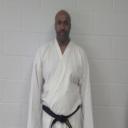Yahoo Answers is shutting down on May 4th, 2021 (Eastern Time) and beginning April 20th, 2021 (Eastern Time) the Yahoo Answers website will be in read-only mode. There will be no changes to other Yahoo properties or services, or your Yahoo account. You can find more information about the Yahoo Answers shutdown and how to download your data on this help page.
Trending News
What are these movements in Pinan Sono san?
https://www.youtube.com/watch?v=Rock1v3ywcM
First of all my version is called Pinan 3 and is slightly different than this version,
1: Is there anything special about the hammer at 2:54? For some reason we practice it slow (called a pull tension) We also drag it across our body (we move into a cat stance and move both our foot and our arm straight across out body, what is the bunkai of this?)
2: Okay this is where it gets interesting, 2:58: what is this move called? I have several theories on it but no one really seems to know what it is? I've been told its some sort of headlock (guillotine, headlock, another im not sure the name of), as well as its origin was called the presenting of the blades because you held to weapons to your side, if you know anything about that PLEASE explain. Ive also heard (some styles practice it with the fists behind the back) this was a move for practicing defense against restraint and to protect the kidneys? We were taught the elbow movement was a block but we do not dip down like that in our style? We also throw an inverted punch instead of a backfist.
3: We have the move at 3:15 and were taught it is the basis for a throw. I've also heard its an elbow strike. But while we do the move twice, we dont do that little side shuffle hop, whats the point of that? Thanks!
8 Answers
- jwbulldogsLv 77 years agoFavorite Answer
There is no one explanation for these. It can be many things. This kata is different than what I do. Where he does a hammer fist at 2:58. This is where the hidden fist technique is introduced in the Pinan Series. This can be a spinning back fist/ hammer fist. It can be a throw.
2 At 2:58 I would say that the presenting of the blades are just myths. Remember karate is empty hands. This is self defense without weapons. Kobudo is the Okinawan art that is practiced along with karate which is with weapons. This technique has many application. it depends on what you are working on in bunkai. it can be a choke. It can be a joint lock. it can be signifying which pressure point you are going to strike. It can also be a throw. This technique is unique in the Pinan series.
3 Yes this is or can be a throw. One throw I use here is merote seo nage (two arm shoulder throw). It can also be an elbow s It can be an escape from a grab from behind. It can be an escape from a choke from behind.
I can't explain the hop. We don't teach that. We do both side as everything done on the left is done on the right.
I'm interested in knowing more about the shuto strkes done in these kata? This is not how I was taught to do them. i don't know of anyone doing it like that.
Source(s): Martial Arts since 1982 - 7 years ago
Well the first movement and technique that you are asking about some think is a combination of several things. I am sure you have seen when someone sometimes gets punched or stabbed they re-actively reach down to that area and sometimes grip that which has just stabbed or hit them. The spear hand thrust that you see in this kata in many styles leading up to this sequence is thought to be the reason for this and when your adversary reaches down and grips your hand and lower arm after being struck you are then turning and pulling him across your body, using your hips and lower center of gravity to cause him to fall forward past you on the ground.
Your second question touches on the aspect of brushing and how various parts of your body can be used to brush something to the side that is coming straight at you rather than blocking it. Blocking it takes more time, is a much bigger motion or action, and also expends more energy. Brushing gives you more time to react because its a shorter or smaller motion, and requires almost no energy at all since you are meeting the technique from the side and just pushing it further to the side before it hits you rather than meeting the force of it more directly. You can brush things to the side with your shoulders, upper arms, lower arms, hips, upper and lower legs and you will see fighters in the ring use and rely on this all the time rather than trying to actually block something all the time.
- ?Lv 47 years ago
My experience is that the talk of hidden applications is for those that have never actually studied the kata and the writings. Itosu Anko, the person who made all the pinan Kata in 1904 wrote that the pinan were about punching kicking and preparing "Middle schools students" for military service. I reviewed Kata by looking at ALL variations of Pinan and found that Choshin Chibana's version seems to be the best preserved (based on looking at all styles and looking at the changes) Itosu Anko stressed that His Kata were based on Ikken hissatsu and for multiple attackers so the idea of grappling is off based on the founders words. If you want to see how to use the Kata usin disabling blows check this book out
- How do you think about the answers? You can sign in to vote the answer.
- pugpaws2Lv 77 years ago
First every style that has Pinian (Heian) Kata has slightly different ways of doing them. All Kata has hidden applications that the moves and static positions represent. However, each style may have different applications for the same move. There are multiple explanations for an one position, stance, and movement. To give a better picture of this consider this.... The version of Naihanchi-Shodan i do has about 34-36 moves total. however everything is repeated both left ad right versions during the Kata. Therefore there are only about 16 or 17 different techniques. Of that small number of techniques I have cataloged more than 51 different real life applications for those techniques. some moves I have only one or two different applications. for some I have as many as seven different ways/applications that that technique can be used in real life.
No one knows all the applications for any Kata. what is unfortunate is many people learn Kata but are never taught any of the real hidden applications. I myself started learning Kata in 1967. At that time we were told that there were hidden applications for the moves in the Kata. but my early instructors did not teach any of them. Many years later I began to understand that although my instructors said there were hidden applications, they had not learned them themselves. In the early 1980's I was lucky enough to meet people that understood the hidden applications and was taught a lot about them. Some years later I went to visit one of my early instructors from the 1969-1972 time span only to learn that he had never learned anything about the hidden applications in the Kata he taught us. He was still looking for the hidden applications but had never been taught them. It was sad to learn of his death two years ago and know that after all the years he trained he never knew the proper hidden bunkai of his Kata.
...
Source(s): Martial arts training and research over 47 years (since 1967). Teaching martial arts since 1973. - ?Lv 47 years ago
I really like how this is used to teach students to telegraph EVERYTHING they are going to do and how to generate absolutely no power with any strike. If this is used to train and create muscle memory, everyone doing this dance learns to telegraph so a blind person can tell what they are going to do or when and where they will move. Teaching this produces ineffective fighting methods
- 7 years ago
They are what they appear to be and what they can be interpreted to be. Different teachers will have different interpretations based on their experience. Start by asking your instructors. Then, do reading and research. I would also ask some of the more experienced karateka here what their Bunkai for the form is.




